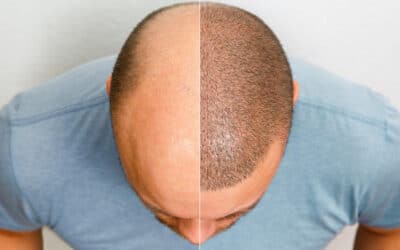Can You Stop Male Pattern Baldness?
Finding a way to stop male pattern baldness is not as straightforward as one might think. It’s not as simple as one simple problem with one simple cure. There are many reasons why men lose their hair, and sometimes there may even be more than one contributing factor. Let’s explore some of the underlying causes of male pattern baldness as well as the most effective treatments. While there is no surefire way to stop male pattern baldness, there are lots of effective treatments and solutions. Let’s take a closer look.
First, You Must Understand Male Pattern Baldness
It’s always important to understand what you’re up against before undertaking any battle. Male pattern baldness is most often caused by genetic factors, hormonal conditions, or both. By the time men reach the age of 50, more than half will experience some degree of hair loss. Though most commonly expressed in men who are middle-aged and older, others see signs of pattern baldness as early as adolescence. Hair loss can occur at any age. Other factors include stress, anxiety, traumatic experiences such as a major accident, medical conditions, reaction to medications, heavy metal exposure, and nutritional deficiencies.
Male pattern baldness usually begins with a receding hairline or overall diffuse thinning of hair. Other early signs include a more pronounced widow’s peak. Furthermore, you may notice your hairline starting to resemble an “M” shape, new bald spots, or increased shedding. If you suspect male pattern baldness could be the culprit, it’s best to get it checked out with your doctor. They can help determine the root causes as well as the most appropriate treatment plan.
Androgenic Alopecia & DHT
The most common cause of male pattern baldness is androgenic alopecia, which is thought to have several different genes that contribute to this condition. One of the things found in those with androgenic alopecia is the presence of androgenic hormones such as testosterone and dihydrotestosterone (DHT). For those with androgenic alopecia, the formation of DHT in the hair follicle causes that follicle to shrink and produce thinner more delicate hair until eventually, the follicle stops growing hair altogether.
The shrinking of hair follicles is what causes the hair to stop growing. To a certain extent, this is a natural part of the aging process. Most people will experience a certain degree of thinning hair as they age, in the same way, that most aging people will experience graying hair. Those with androgenic alopecia often experience this hair loss at a more accelerated rate. However, people with androgenic alopecia seem to have greater sensitivity to hormones like DHT.
DHT is produced by the 5-alpha reductase enzyme, which is responsible for converting some of the circulating testosterone in the body into DHT on an ongoing basis. The 5-alpha reductase enzyme can also be found in the prostate, liver, skin, and hair follicles. DHT is an important hormone that is responsible for helping form male genitalia. It’s also a secondary sex characteristic in puberty.
For some men, DHT has very little effect. It circulates freely throughout the body without impacting the appearance of their hair at all. For others that are more genetically sensitive, DHT causes hair loss by binding to the hair follicles. When DHT binds to the hair follicles they begin to shrink and grow weaker, which slows down the rate of growth for the hair. Over time the hair follicles stop producing altogether.
Stop Male Pattern Baldness Before It Starts
The earlier that one experiences male pattern hair loss, the likelier it is that they are very sensitive to DHT. You are at higher risk for experiencing male pattern baldness if you have a family history of hair loss. Contrary to popular myths, you can inherit hair loss genes from either or both sides of your family, not just your maternal side.
As soon as you start to notice symptoms of male pattern baldness, seek out medical advice. The longer you wait without treating the problem, the more severe the issue will become. By getting professional help early on, you can prevent any further hair loss, and you may be able to restore some of your lost hair. To diagnose male pattern baldness, your healthcare provider will usually examine your scalp to determine things like whether or not you’ve lost a significant amount of hair.
They look for evidence of the miniaturization of your hair follicles, and to look at and measure the space between each hair follicle. There’s usually no need to perform a biopsy to diagnose male pattern baldness, but your healthcare provider may ask questions about your health history as well as your family’s history of hair loss. Most healthcare professionals classify male pattern baldness using a system called the Norwood scale which features reference diagrams for a variety of hair loss patterns, ranging from a receding hairline to almost complete hair loss.
Stopping Male Pattern Baldness With Meds
The most effective medications for male pattern baldness are topical treatments. Minoxidil, also known as Rogaine, and finasteride, which blocks DHT. These treatments work best if started early, and must be used continuously in order to be effective. If you stop taking these medications your hair loss will continue as before. While we definitely do recommend use of meds for some men, it’s not all sunshine and rainbows. Some men report undesirable sexual side effects. These include impotency and lack of sexual desire from finasteride, as a result of its DHT blocking action. These treatments may also not be effective if your hair loss is in the advanced stages.
Hair transplantation surgery is an effective and permanent way to restore thinning hair. Transplants reverse the appearance of male pattern baldness. There are two main ways of performing hair transplantation surgery. They differ according to the method used to harvest the donor hair follicles for transplantation. Frequently, donor hairs are harvested from the back of the head, where the hair tends to be thicker, and the follicles are less vulnerable to DHT.
With follicular unit transplantation (FUT) the surgeon harvests the follicular grafts by cutting small vertical incisions to remove small strips of the scalp along with hair follicles, before transplanting the grafts. With follicular unit extraction (FUE) the doctor uses a small micro punch tool to remove the follicles individually, in a diffuse pattern that is spread out throughout the donor area.
Which Hair Transplant Surgery Is The Best Option For Me?
Both surgeries are very effective and have comparable success rates. There are pros and cons to both procedures which you can discuss in greater detail with your doctor. FUE tends to be more time-consuming and expensive, but also has a reduced risk of visible scarring, and is less invasive, resulting in a faster and less painful recovery. FUT is less expensive and less time-consuming, but is also more invasive, and may involve a bit more discomfort in the early recovery stages.
Both procedures involve the transplantation of your own natural hair. They have a very low risk of side effects, especially when proper after-care measures are taken. It’s not a quick fix, and like any procedure, results are not instantaneous. Additionally, there are times of adjustment. Ups and downs. The usual. It takes about a year for the newly transplanted hair follicles to heal, become well established, and grow. However, once that year is passed you will see significantly fuller hair.
Hair transplantation is a process that requires a lot of patience. However, for those who have struggled with hair loss, seeing their hair restored is well worth the wait. While there is no sure-fire way to stop male pattern baldness, hair transplantation is a long-term solution that can safely and effectively restore your natural hair. At this point in time, it’s the best hair restoration option available. We highly recommend you look into hair transplantation to stop male pattern baldness and reverse hair loss.
SUFFERING FROM MALE PATTERN BALDNESS?
Best Hair Transplant is the best place to schedule your hair transplant in Los Angeles. We’ve helped both men and women regrow their lost hair. But don’t take our word for it. We suggest learning as much as possible about hair restoration. Do so prior to making a decision on how to address your hair loss. Not every procedure is right for everyone.
At Best Hair Transplant, we’re proud of our results and happy to provide hair restoration services. Additionally, we’re proud to make hair transplants affordable and help you save money on a variety of hair transplants. To ensure your ease of mind, you can view our customer recommendations HERE. Furthermore, you can also see our Google reviews and Yelp reviews. We can’t wait to help you start restoring your lost hair.
YOUR HAIR RESTORATION SOLUTION
Best Hair Transplant
1970 S. Prospect Ave., Suite 2
Redondo Beach, CA 90277
(213) 403-0455











